Asmaa Abdallah
Near-Field Beam Prediction Using Far-Field Codebooks in Ultra-Massive MIMO Systems
Mar 18, 2025Abstract:Ultra-massive multiple-input multiple-output (UM-MIMO) technology is a key enabler for 6G networks, offering exceptional high data rates in millimeter-wave (mmWave) and Terahertz (THz) frequency bands. The deployment of large antenna arrays at high frequencies transitions wireless communication into the radiative near-field, where precise beam alignment becomes essential for accurate channel estimation. Unlike far-field systems, which rely on angular domain only, near-field necessitates beam search across both angle and distance dimensions, leading to substantially higher training overhead. To address this challenge, we propose a discrete Fourier transform (DFT) based beam alignment to mitigate the training overhead. We highlight that the reduced path loss at shorter distances can compensate for the beamforming losses typically associated with using far-field codebooks in near-field scenarios. Additionally, far-field beamforming in the near-field exhibits angular spread, with its width determined by the user's range and angle. Leveraging this relationship, we develop a correlation interferometry (CI) algorithm, termed CI-DFT, to efficiently estimate user angle and range parameters. Simulation results demonstrate that the proposed scheme achieves performance close to exhaustive search in terms of achievable rate while significantly reducing the training overhead by 87.5%.
Near-Field ISAC: Synergy of Dual-Purpose Codebooks and Space-Time Adaptive Processing
Jan 15, 2025



Abstract:Integrated sensing and communication (ISAC) has emerged as a transformative paradigm, enabling situationally aware and perceptive next-generation wireless networks through the co-design of shared network resources. With the adoption of millimeter-wave (mmWave) and terahertz (THz) frequency bands, ultra-massive MIMO (UM-MIMO) systems and holographic surfaces unlock the potential of near-field (NF) propagation, characterized by spherical wavefronts that facilitate beam manipulation in both angular and range domains. This paper presents a unified approach to near-field beam-training and sensing, introducing a dual-purpose codebook design that employs discrete Fourier transform (DFT)-based codebooks for coarse estimation of sensing parameters and polar codebooks for parameter refinement. Leveraging these range and angle estimates, a customized low-complexity space-time adaptive processing (STAP) technique is proposed for NF-ISAC to detect slow-moving targets and efficiently mitigate clutter. The interplay between codebooks and NF-STAP framework offers three key advantages: reduced communication beam training overhead, improved estimation accuracy, and minimal STAP computational complexity. Simulation results show that the proposed framework can reduce STAP complexity by three orders of magnitude, validating efficacy, and highlighting the potential of the proposed approach to seamlessly integrate NF communication and sensing functionalities in future wireless networks.
NetOrchLLM: Mastering Wireless Network Orchestration with Large Language Models
Dec 13, 2024Abstract:The transition to 6G networks promises unprecedented advancements in wireless communication, with increased data rates, ultra-low latency, and enhanced capacity. However, the complexity of managing and optimizing these next-generation networks presents significant challenges. The advent of large language models (LLMs) has revolutionized various domains by leveraging their sophisticated natural language understanding capabilities. However, the practical application of LLMs in wireless network orchestration and management remains largely unexplored. Existing literature predominantly offers visionary perspectives without concrete implementations, leaving a significant gap in the field. To address this gap, this paper presents NETORCHLLM, a wireless NETwork ORCHestrator LLM framework that uses LLMs to seamlessly orchestrate diverse wireless-specific models from wireless communication communities using their language understanding and generation capabilities. A comprehensive framework is introduced, demonstrating the practical viability of our approach and showcasing how LLMs can be effectively harnessed to optimize dense network operations, manage dynamic environments, and improve overall network performance. NETORCHLLM bridges the theoretical aspirations of prior research with practical, actionable solutions, paving the way for future advancements in integrating generative AI technologies within the wireless communications sector.
Antenna Selection With Beam Squint Compensation for Integrated Sensing and Communications
Jul 14, 2023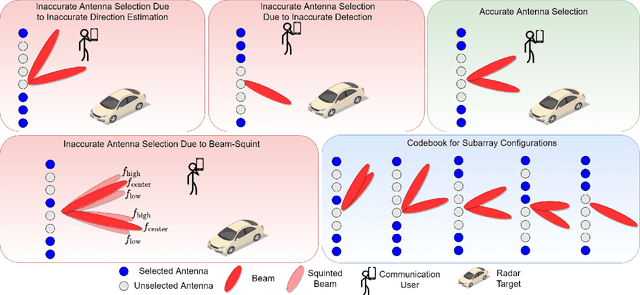
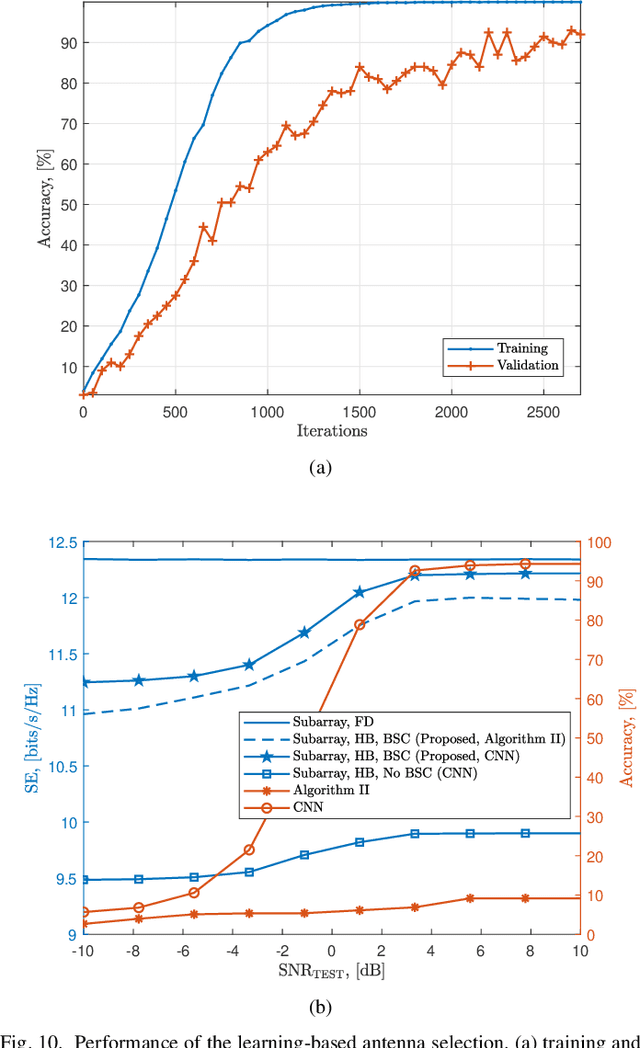
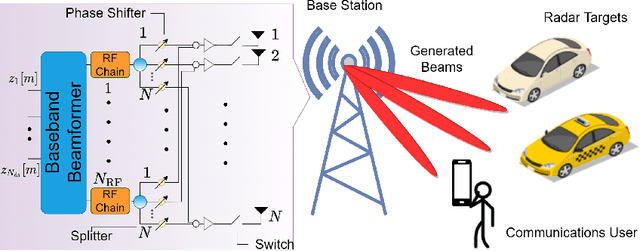

Abstract:Next-generation wireless networks strive for higher communication rates, ultra-low latency, seamless connectivity, and high-resolution sensing capabilities. To meet these demands, terahertz (THz)-band signal processing is envisioned as a key technology offering wide bandwidth and sub-millimeter wavelength. Furthermore, THz integrated sensing and communications (ISAC) paradigm has emerged jointly access spectrum and reduced hardware costs through a unified platform. To address the challenges in THz propagation, THz-ISAC systems employ extremely large antenna arrays to improve the beamforming gain for communications with high data rates and sensing with high resolution. However, the cost and power consumption of implementing fully digital beamformers are prohibitive. While hybrid analog/digital beamforming can be a potential solution, the use of subcarrier-independent analog beamformers leads to the beam-squint phenomenon where different subcarriers observe distinct directions because of adopting the same analog beamformer across all subcarriers. In this paper, we develop a sparse array architecture for THz-ISAC with hybrid beamforming to provide a cost-effective solution. We analyze the antenna selection problem under beam-squint influence and introduce a manifold optimization approach for hybrid beamforming design. To reduce computational and memory costs, we propose novel algorithms leveraging grouped subarrays, quantized performance metrics, and sequential optimization. These approaches yield a significant reduction in the number of possible subarray configurations, which enables us to devise a neural network with classification model to accurately perform antenna selection.
Spatial Path Index Modulation in mmWave/THz-Band Integrated Sensing and Communications
Mar 22, 2023Abstract:As the demand for wireless connectivity continues to soar, the fifth generation and beyond wireless networks are exploring new ways to efficiently utilize the wireless spectrum and reduce hardware costs. One such approach is the integration of sensing and communications (ISAC) paradigms to jointly access the spectrum. Recent ISAC studies have focused on upper millimeter-wave and low terahertz bands to exploit ultrawide bandwidths. At these frequencies, hybrid beamformers that employ fewer radio-frequency chains are employed to offset expensive hardware but at the cost of lower multiplexing gains. Wideband hybrid beamforming also suffers from the beam-split effect arising from the subcarrier-independent (SI) analog beamformers. To overcome these limitations, this paper introduces a spatial path index modulation (SPIM) ISAC architecture, which transmits additional information bits via modulating the spatial paths between the base station and communications users. We design the SPIM-ISAC beamformers by first estimating both radar and communications parameters by developing beam-split-aware algorithms. Then, we propose to employ a family of hybrid beamforming techniques such as hybrid, SI, and subcarrier-dependent analog-only, and beam-split-aware beamformers. Numerical experiments demonstrate that the proposed SPIM-ISAC approach exhibits significantly improved spectral efficiency performance in the presence of beam-split than that of even fully digital non-SPIM beamformers.
RIS-Assisted Grant-Free NOMA
Jul 23, 2022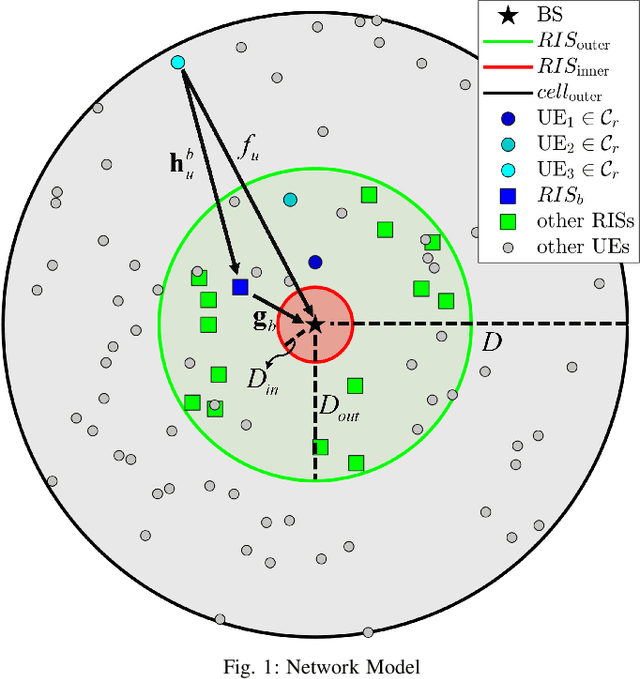
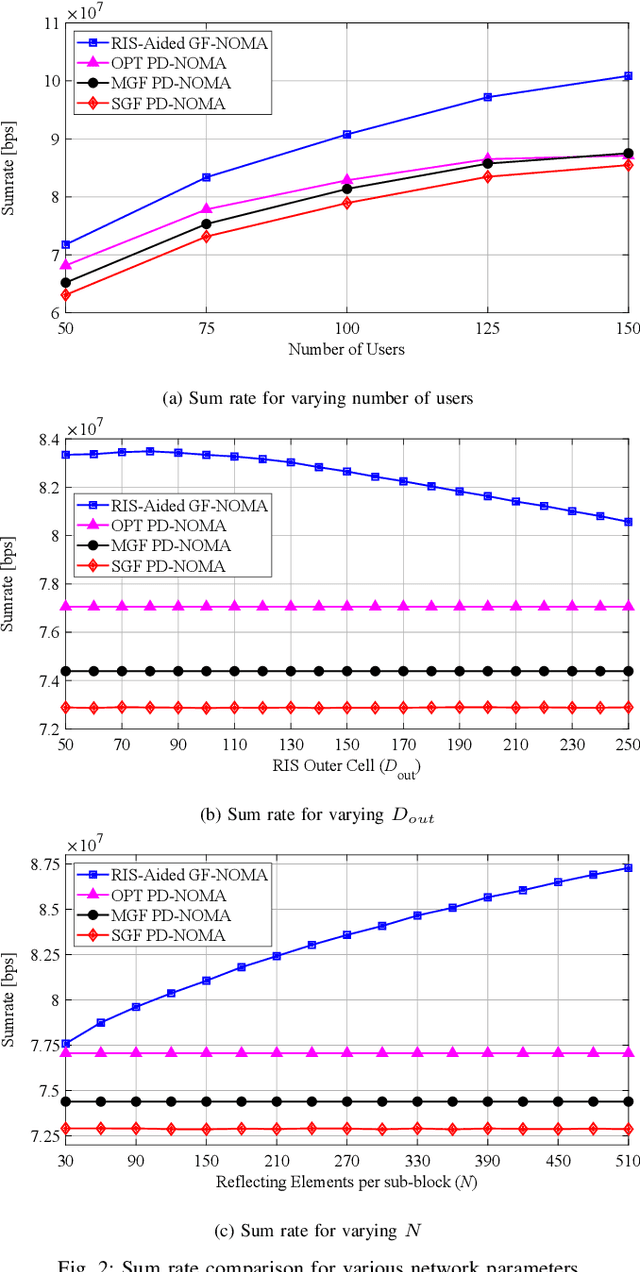
Abstract:This paper introduces a reconfigurable intelligent surface (RIS)-assisted grant-free non-orthogonal multiple-access (GF-NOMA) scheme. To ensure the power reception disparity required by the power domain NOMA (PD-NOMA), we propose a joint user clustering and RIS assignment/alignment approach that maximizes the network sum rate by judiciously pairing user equipments (UEs) with distinct channel gains, assigning RISs to proper clusters, and aligning RIS phase shifts to the cluster members yielding the highest cluster sum rate. Once UEs are acknowledged with the cluster index, they are allowed to access their resource blocks (RBs) at any time requiring neither further grant acquisitions from the base station (BS) nor power control as all UEs are requested to transmit at the same power. In this way, the proposed approach performs an implicit over-the-air power control with minimal control signaling between BS and UEs, which has shown to deliver up to 20% higher network sum rate than benchmark GF-NOMA and optimal grant-based PD-NOMA schemes depending on the network parameters. The given numerical results also investigate the impact of UE density, RIS deployment, and RIS hardware specifications on the overall performance of the proposed RIS-aided GF-NOMA scheme.
Terahertz-Band MIMO-NOMA: Adaptive Superposition Coding and Subspace Detection
Mar 03, 2021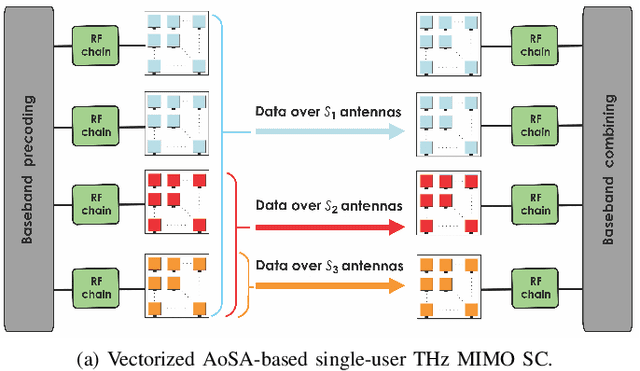
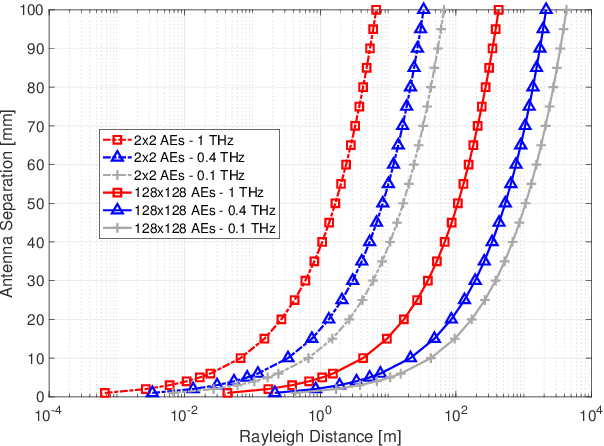

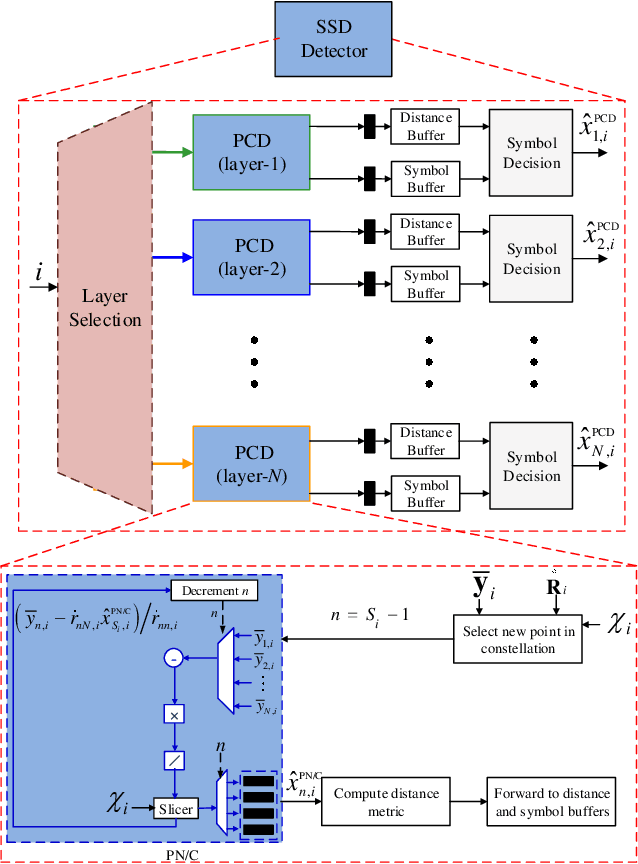
Abstract:We consider the problem of efficient ultra-massive multiple-input multiple-output (UM-MIMO) data detection in terahertz (THz)-band non-orthogonal multiple access (NOMA) systems. We argue that the most common THz NOMA configuration is power-domain superposition coding over quasi-optical doubly-massive MIMO channels. We propose spatial tuning techniques that modify antenna subarray arrangements to enhance channel conditions. Towards recovering the superposed data at the receiver side, we propose a family of data detectors based on low-complexity channel matrix puncturing, in which higher-order detectors are dynamically formed from lower-order component detectors. We first detail the proposed solutions for the case of superposition coding of multiple streams in point-to-point THz MIMO links. We then extend the study to multi-user NOMA, in which randomly distributed users get grouped into narrow cell sectors and are allocated different power levels depending on their proximity to the base station. We show that successive interference cancellation is carried with minimal performance and complexity costs under spatial tuning. We derive approximate bit error rate (BER) equations, and we propose an architectural design to illustrate complexity reductions. Under typical THz conditions, channel puncturing introduces more than an order of magnitude reduction in BER at high signal-to-noise ratios while reducing complexity by approximately 90%.
 Add to Chrome
Add to Chrome Add to Firefox
Add to Firefox Add to Edge
Add to Edge